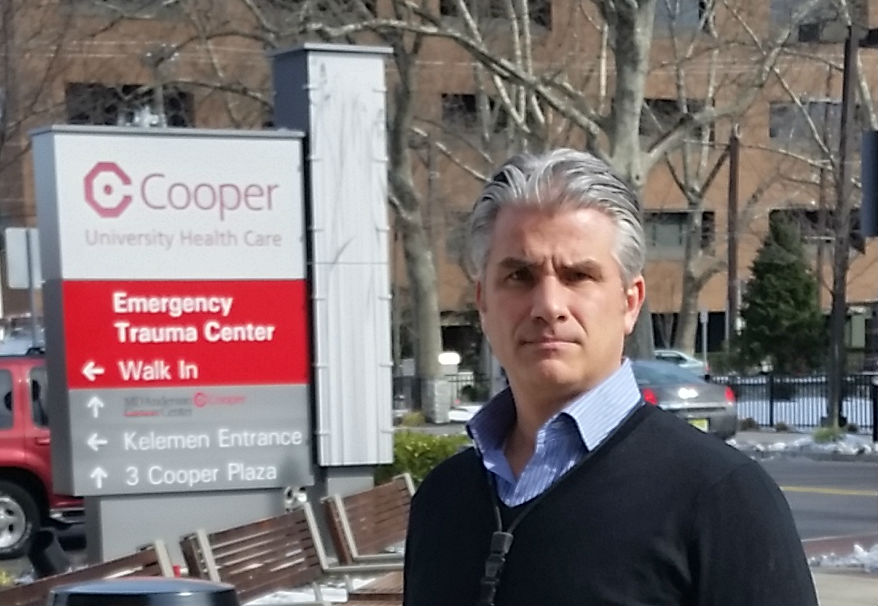FOR DR. SHILLING, A LIFE OF MEDICINE WAS ALWAYS IN THE CARDS
Al Thompson
 Dr. Jack Shilling brings over 15 years of surgical experience to the Cooper Bone and Joint Institute. Photo by Al Thompson.
Dr. Jack Shilling brings over 15 years of surgical experience to the Cooper Bone and Joint Institute. Photo by Al Thompson. Most kids, when they talk about what they want to be when they grow up, usually change their mind a few times before he or she find their station in life.
That was not the case with Jack Shilling.
Shilling said he knew from an early age that medicine is what he wanted to pursue from the minute he could think.
He now works for the Cooper Bone and Joint Institute and is the Director of the Adult Reconstructive Orthopedic Program at Cooper Medical Center in Camden.
Dr. Shilling talked about the moment he knew he wanted to be a doctor.
“The moment I had was when I was five years old and broke my leg,” Dr. Shilling recalled. “An orthopedic surgeon helped me out. It was not necessarily an injury on the field, although I had plenty of doctors during my high school years and even during my college years that gave me more and more influence.”
Dr. Shilling grew up in Western Pennsylvania, playing many different sports, and playing them well. His interest in medicine grew as he developed into an outstanding athlete who would go on to play football in college.
Like any kid in Western Pennsylvania in the late 70s, Dr. Shilling grew up an avid Steelers fan.
Pittsburgh was coming off their fourth Super Bowl win in 1980, right as Dr. Shilling was entering high school, Steelers Nation was at its peak and the young athlete with medical aspirations was as wide-eyed as any adolescent would be when he actually had the chance to connect with the team he loved.
“When I was 12, I was in a program where I had the opportunity to meet a doctor who worked for the Steelers, Dr. James McMaster,” Dr. Shilling remembered. “I was a sixth-grader, a 12-year kid, he was a sports guy who was larger than life for me at the time and he worked on the Steelers (players). So I got to write a report on him I got to meet with him, he was definitely somebody who made an impression on me. He sort of crystallized the orthopedic surgery side of what I wanted to do in medicine and it went from there.”
Dr. Shilling played football and ice hockey for Franklin Regional High School in Murrysville, PA. He was a wide receiver and defensive back for the Panthers. He was also the backup quarterback.
Dr. Shilling went on to play wide receiver at Franklin & Marshall College and there he met another leader who would help shape his future.
Dr. Shilling was coached by Tom Gilburg, the head football coach at Franklin & Marshall College in Lancaster, Pennsylvania for 28 seasons, from 1975 until 2002, compiling a record of 160–112–2.
Gilburg was a punter and second-string offensive tackle for the Baltimore Colts of the National Football League from 1961 to 1965. He had been selected in the second round (21st overall) by the Colts from Syracuse University in the 1961 NFL Draft.
Dr. Shilling said that Gilburg and Franklin & Marshall had such an impact on him that he has stayed involved with the school on several levels. He currently serves as the treasurer for the Alumni Association Board.
Dr. Shilling said he was able to use his gifts to give back to one of the biggest influences in his life. He made the right career choices as his sports and medical experiences unfolded.
At one time Dr. Shilling said he was sure a pure sports medicine career was in his future, but things changed.
“As I grew, I really thought I’d be a sports doctor because I played every sport under the sun and had a bunch of injuries, “Dr. Shilling said. “I broke 11 bones over the years, torn ligaments, dislocated fingers…I was always too small to be playing some of the sports I was playing, I kind of threw myself around and got beaten up, but there is no doubt I do what I do today in medicine because of my experiences with sports and injuries.
“I went to do my residency,” he continued. “At the time I was going to be a sports doctor and found that I enjoyed the replacement surgery more than I did some of the sports surgery, so I ended up gravitating in that direction.”
Dr. Shilling now brings over 15 years of surgical experience to the Cooper Bone and Joint Institute. Most recently, Dr. Shilling was a Joint Reconstruction Surgeon at Aria 3B Orthopaedic Specialists in Langhorne, PA. Prior to that, he was the Director of Adult Reconstructive Orthopaedics and Orthopaedic Trauma for the Einstein Healthcare Network in Philadelphia, PA.
Dr. Shilling received his medical degree from Hahnemann University School of Medicine, in Philadelphia, PA. He completed a surgical internship at Penn State University, Hershey Medical Center, and completed his residency at the University of Rochester, in Rochester, NY. He also pursued Fellowship training in Adult Reconstructive Orthopaedics, at Thomas Jefferson University Hospital, in Philadelphia, PA.
That is an impressive resume by any standards, but the kid in us and the love for mentors, coaches and others who showed they cared about us from the beginning never dies.
“One of my most proud moments is the fact that I replaced both hips of my college football coach,” said Dr. Shilling, talking about coach Gilburg. “That was sort of a full circle moment because he was an important guy in my life, to be able to come back and help him on the back end with problems he had later was really a special thing.”
Dr. Shilling specializes in the areas of hip and knee joint replacement and arthritis. He has special interest in complex hip and knee reconstruction including high-risk primary arthroplasty, revision arthroplasty, periprosthetic fractures, and infection.
“I am still part of the trauma call schedule and Cooper takes a lot of trauma unit so I still fix fractures and things like that,” Dr. Shilling said. “But basically I spend most of my time doing joint replacement surgery and dealing with infections and fractures associated with that and some of the complicated cases that come with that.”
Dr. Shilling’s goal is to lead and grow the Joint Replacement and Reconstruction Program by offering patients the most advanced surgical techniques and best clinical outcomes possible.
“We are doing everything we can right now to take current technology for joint replacements to a place where these things last longer, they are more durable, people can get them at younger ages and do more with them,” said Dr. Shilling, who reports he works with Zimmer Biomet, a national company that offers support to orthopaedic surgeons and clinicians to restore mobility and treat arthritis, traumatic injuries and joint replacement technologies. “That is a constant battle and will be that battle along the way. Now running parallel to that, taking current technology, current ideology and making it as good as it can possibly be is the idea of cartilage regeneration and growth. You could argue that the goal of my world is to eliminate the surgeries that I do by trying to help us when there are cartilage injuries or cartilage wear, to grow cartilage and be able to put that back in your knee or in your hip, or have you regrow your own. We’re still a ways away from that. We can grow cartilage in the lab today we just can’t make it stick to the bone in an effective way, the way Mother Nature can. That is really, in my mind, the future of what we do. But along the way we just keep trying to get better, better and better with what we have now.”
Dr. Shilling talked about how joint treatment and replacement is growing as fast as any field in the medical arena. Advancements in the longevity of knee and hip replacement are making it more attractive to younger patients knowing they will most likely only have the surgery once in their lifetime.
“The number of hip and knee replacements done in this world, done in this country continues to climb, the complexity of the cases in terms of infections and revisions increases, the age of the patients getting this surgery has declined, the quality of the surgeries and the search for techniques we use…I’ve been in practice for 17 years…I do things in certain ways exactly the same as I’ve always done them but in many, many ways the incisions are a third of the size and the section is a third of what it used to be. We’ve gotten so much better at taking better care of people, helping these things last longer, keeping people active.
“What I’ve seen as time goes by,” Dr. Shilling continued, is that I take care of a lot of people after their sports injuries have taken their toll. I may not help keep them on the field but I definitely help them after the field has beaten them up a bit.”
Dr. Shilling said that with the large Camden community, its diversity and the high number of fractures and the referrals that Cooper gets hit with, produce higher cases of infections and other complications that Shilling and the staff at the hospital are given the task of dealing with.
Still he says the overall quality of his field has improved consistently.
“The surgeries are much more predictable,” Dr. Shilling said. “But at the same time when you work in a place like Camden, and this is a big referral center for some of the more complex stuff in terms of infections and fractures, just generalized complications with those kinds of cases tend to come here for us to deal with. So it’s a highly complex place.”
Dr. Shilling said infections from the hip and knee replacements still occur, and he and his fellow orthopedic surgeons are getting better and better all the time.
“The percentage of infections is less than one percent across the board for all comers,” Dr. Shilling said. “That doesn’t mean if it happens to you it isn’t a total nightmare. We battle to prevent that and I think we’re better and better at preventing complications and having really outstanding outcomes than we ever have before. But it will always be a battle.”
Not nearly every patient is a former pro or amateur athlete. Many come from lifestyles or a line of work that is very active. Dr. Shilling talked about helping people get back to the life they love and chose.
“When people ask me the ‘why me?’ question, it’s a combination of several things,” Dr. Shilling said. “I usually answer that question by saying it’s who you are and what you do. The ‘who you are’ part is genetic. If you look at x-rays all day you’ll see that while we all have two eyes, a nose and a mouth but nobody looks the same, that’s also true for the rest of your body as well. Hips and knees come in different shapes and sizes in terms of how well the joints move together. You then have issues of cartilage quality, issues of weight, you have people who work as a construction worker, some people sit at a desk. There are just a lot of different factors there. Somewhere in there is you. I use a lot of car analogies. A lot of what happens with hip and knee replacements and arthritic changes is, your car’s been out of alignment for a while. As that changes, things wear out, the tread on your tires wear down. Arthritis is a cartilage problem. People who get hip and knee replacements need their tires changed.”
Just listening to Dr. Shilling gives one confidence that the quality of life improving is something to look forward to. *












